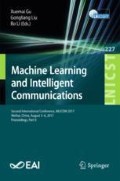Abstract
Ship detection is an important issue in many aspects, vessel traffic services, fishery management and rescue. Synthetic aperture radar (SAR) can produce real high resolution images with relatively small aperture in sea surfaces. A novel method employing extreme learning machine is proposed to detect ship in SAR. After the image preprocessing, some features including entropy, contrast, energy, correlation and inverse difference moment are selected as features for ship detection. The experimental results demonstrate that the proposed ship detection method based on extreme learning machine is more efficient than other learning-based methods with prior performance of accuracy, time consumed and ROC.
Access this chapter
Tax calculation will be finalised at checkout
Purchases are for personal use only
References
Wang, S., Yang, S., Feng, Z., et al.: Fast ship detection of synthetic aperture radar images via multi-view features and clustering. In: International Joint Conference on Neural Networks, pp. 404–410 (2014)
Yang, G., Yu, J., Xiao, C., et al.: Ship wake detection for SAR images with complex backgrounds based on morphological dictionary learning. In: IEEE International Conference on Acoustics, Speech and Signal Processing, pp. 1896–1900. IEEE (2014)
Selvi, M.U., Kumar, S.S.: Sea object detection using shape and hybrid color texture classification. Commun. Comput. Inf. Sci. 204, 19–31 (2011)
Martan-De-Nicols, J., Mata-Moya, D., Jarabo-Amores, M.P., et al.: Neural network based solutions for ship detection in SAR images. In: International Conference on Digital Signal Processing, pp. 1–6. IEEE (2013)
Khesali, E., Enayati, H., Modiri, M., et al.: Automatic ship detection in single-pol SAR images using texture features in artificial neural networks. Int. Archiv. Photogrammetry Remote Sens. XL-1-W5, 395–399 (2015)
Yang, X., Bi, F., Yu, Y., et al.: An effective false-alarm removal method based on OC-SVM for SAR ship detection. In: IET International Radar Conference, pp. 1–4. IET (2015)
Ma, L.: Support tucker machines based marine oil spill detection using SAR images. Indian J. Geo-Marine Sci. 45, 1445–1449 (2016)
Ma, L., Hu, Y., Zhang, Y.: Support tucker machines based bubble defect detection of lithium-ion polymer cell sheets. Eng. Lett. 25, 46–51 (2017)
Schwegmann, C.P., Kleynhans, W., Salmon, B.P., et al.: Very deep learning for ship discrimination in synthetic aperture radar imagery. In: 2016 IEEE International Geoscience and Remote Sensing Symposium, pp. 104–107. IEEE (2016)
Huang, G.B., Zhu, Q.Y., Siew, C.K.: Extreme learning machine: theory and applications. Neurocomputing 70, 489–501 (2006)
Huang, G., Huang, G.B., Song, S., You, K.: Trends in extreme learning machines: a review. Neural Netw. 61, 32–46 (2015)
Huang, G.B., Zhou, H., Ding, X., Zhang, R.: Extreme learning machine for regression and multiclass classification. IEEE Trans. Syst. Man Cybern. 2, 513–529 (2016)
Wang, S., Deng, C., Lin, W., Huang, G.B.: NMF-based image quality assessment using extreme learning machine. IEEE Trans. Cybern. 255–258 (2016)
Yüksel, T.: Intelligent visual servoing with extreme learning machine and fuzzy logic. Expert Syst. Appl. 47, 232–243 (2017)
Liu, X., Deng, C., Wang, S., Huang, G.B., Zhao, B., Lauren, P.: Fast and accurate spatiotemporal fusion based upon extreme learning machine. IEEE Geosci. Remote Sens. Lett. 13, 2039–2043 (2016)
TerraSAR-X Data Samples. http://www.infoterra.de/free-sample-data
Benco, M., Hudec, R., Kamencay, P., et al.: An advanced approach to extraction of colour texture features based on GLCM. Int. J. Adv. Robot. Syst. 11, article no 104 (2014)
Acknowledgments
This work was partly supported by National Natural Science Foundation of China (No. 61371045).
Author information
Authors and Affiliations
Corresponding author
Editor information
Editors and Affiliations
Rights and permissions
Copyright information
© 2018 ICST Institute for Computer Sciences, Social Informatics and Telecommunications Engineering
About this paper
Cite this paper
Ma, L., Tang, L., Xie, W., Cai, S. (2018). Ship Detection in SAR Using Extreme Learning Machine. In: Gu, X., Liu, G., Li, B. (eds) Machine Learning and Intelligent Communications. MLICOM 2017. Lecture Notes of the Institute for Computer Sciences, Social Informatics and Telecommunications Engineering, vol 227. Springer, Cham. https://doi.org/10.1007/978-3-319-73447-7_60
Download citation
DOI: https://doi.org/10.1007/978-3-319-73447-7_60
Published:
Publisher Name: Springer, Cham
Print ISBN: 978-3-319-73446-0
Online ISBN: 978-3-319-73447-7
eBook Packages: Computer ScienceComputer Science (R0)

